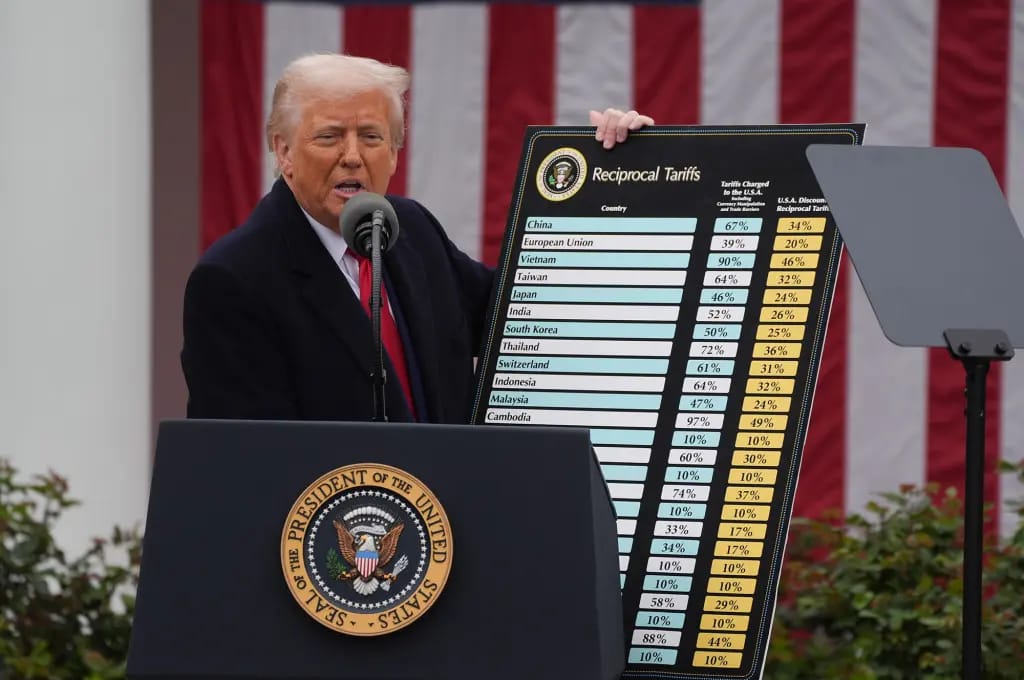- The Situation Room
- Posts
- The Situation Room - November 5th
The Situation Room - November 5th
Good morning everyone,
The Future of the Content Economy
beehiiv started with newsletters. Now, they’re reimagining the entire content economy.
On November 13, beehiiv’s biggest updates ever are dropping at the Winter Release Event.
For the people shaping the next generation of content, community, and media, this is an event you won’t want to miss.
I’m Atlas, and welcome to The Situation Room! We cover the most high impact geopolitical developments every Wednesday!
Today’s topics:
Worldwide Implications For Trump SCOTUS Case Approaches
U.S. Proposes A UN Force For Gaza Stability
U.S. Sanctions North Korean Bankers Involved In Money Laundering & Cyber-Crime
Worldwide Implications For Trump SCOTUS Case Approaches

Trump displaying tariffs to the press (Washington Post via Getty Images)
By: Atlas
The Supreme Court is set to hear consolidated challenges to President Donald Trump’s use of the 1977 International Emergency Economic Powers Act (IEEPA) to impose broad, worldwide tariffs that the administration says are needed to confront trade deficits, fentanyl-linked imports, and nonreciprocal treatment by key U.S. trading partners. The Court agreed to take the case after several lower courts ruled that the president exceeded his authority when he used an emergency statute—historically applied to sanctions and asset freezes—to levy import duties on dozens of countries. Oral arguments have been extended beyond the usual hour, signaling that the justices view the statutory and separation-of-powers questions as significant.
In public comments ahead of the argument, Trump called the dispute “life or death” for U.S. economic security and said that without presidential tariff authority the United States would be “virtually defenseless” against countries that use trade barriers. He will not attend the argument in person; Treasury Secretary Scott Bessent plans to be present. The administration maintains that even if it loses, it can reimpose some duties under other trade laws, but those tools are narrower and slower.
What the justices must decide
At the center of the case is a straightforward question: when Congress authorized a president to “regulate” or “prohibit” importation during an “unusual and extraordinary threat,” did it also, without saying so expressly, give the president power to set tariff rates at the level and breadth Trump used in 2025? Challengers—including importers, small businesses, and a coalition of states—argue that Congress never intended IEEPA to be used as a general tariff law and that, if such authority exists, Congress would have said so clearly. They point to earlier, specific statutes—like Section 301 of the Trade Act of 1974 or Section 232 for national-security tariffs—that show Congress knows how to write tariff authority when it wants to.
The administration’s position is that in the foreign-affairs and national-security context, “regulate importation” is broad enough to include price-based tools such as tariffs. It argues that the emergency it identified—large, persistent trade deficits, unbalanced tariff schedules abroad, and flows tied to fentanyl precursors—falls within IEEPA’s language on “unusual and extraordinary threats.” On that reading, the president may set tariff levels he deems necessary, and courts should defer to the executive’s judgment.
Lower-court rulings and competing readings
Before reaching the Supreme Court, the administration lost in multiple federal courts, including the Court of International Trade and two courts of appeals. Those rulings said either that IEEPA does not cover tariff setting at all, or that even if it did, the president’s explanation of the “emergency” was too far removed from the statute’s original purpose. One district judge also raised the nondelegation doctrine, noting that if IEEPA is interpreted as the administration wants, it would amount to Congress handing over an essentially unlimited tariff power to the executive, with minimal standards to guide it.
The government appealed, arguing that trade and national security are areas where courts traditionally give the president more latitude, and that Congress in 1977 expected emergencies to evolve. The challengers, meanwhile, urged the justices to apply more recent doctrines—like the major-questions doctrine and constitutional-avoidance principles—to read IEEPA narrowly. They say tariffs that have raised nearly $90 billion in a matter of months are “major” in every sense and require clear congressional authorization, not inference.
Potential consequences of the ruling
If the Court upholds Trump’s use of IEEPA, the immediate effect is that the 2025 global and country-specific tariffs stay in place under the existing executive orders. It would also mark the first time the Court squarely approved the use of an emergency economic statute to impose large-scale, peacetime tariffs. That would give Trump, and future presidents, a precedent for using emergency powers to respond to a wide range of trade, supply-chain, or even nontraditional security issues without going back to Congress. Supporters of the tariffs say that is necessary leverage in a trading system where other nations maintain their own barriers.
If the Court rules against the administration, the duties imposed under IEEPA would have to be unwound or replaced. The Treasury Department has already said that, in that scenario, it would look to other authorities to reimpose at least part of the tariff structure, but those laws tend to be narrower (targeting specific products or countries) and often require investigations or consultations. A loss could also trigger claims for refunds by importers on duties already paid; the administration has acknowledged that refunds on a large portion of the 2025 collections are a possibility if the Court invalidates the program.
Beyond trade, the decision will say something about how far a president can go when invoking a broadly worded emergency statute. Several briefs filed in the case warned that if the Court accepts the administration’s theory, future presidents could cite economic or security threats to adopt major policies—on energy, technology, or even certain domestic issues—without Congress. A narrower reading, on the other hand, would reinforce that emergency powers must stay close to the purposes Congress identified.
What to watch next
The Court heard from three principal groups: the administration; business and importer challengers; and states aligned with the challengers. Because the Court extended argument time, justices will have room to test both the statutory text (“regulate importation”) and the constitutional backdrop (Congress’s Article I power to lay and collect duties). Watch for questions about whether the president’s emergency determination is reviewable, and if so, by what standard.
Also watch for how the justices handle the fact that IEEPA has never before been used this way. Some may see that 50-year practice as evidence that Congress did not silently hand over tariff power. Others may see it as showing that Congress wrote IEEPA broadly precisely because it could not foresee future emergencies.
A decision is not expected for several weeks, and could slip into 2026 depending on the complexity of the opinions. When it comes, it will either validate the core economic tool of Trump’s second term or force the administration to rebuild it under more limited trade statutes. Either way, it will become the leading modern case on the intersection of emergency economic powers, trade, and the separation of powers.



Reply